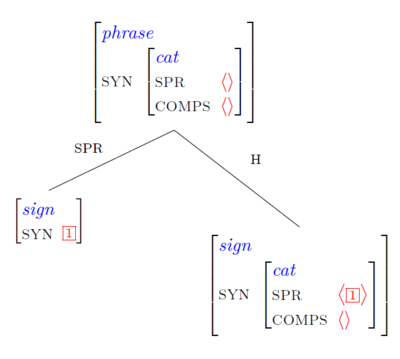Syntax 1 Wiki: Week 4
Looking under the hood
Exercise
Go to the Online Grammar and do the following:
- Type "snores" into the Sentence textbox and press the "Parse" button or RETURN on your keyboard.
- Click once on the top node of the tree.
- Inspect the result and try to understand as much as possible.
Now click on the boxed "0" after AGR.
- Inspect the result and try to understand as much as possible.
Finally, click on the boxed number below the NP in the SPR list.
- Again, inspect the result and try to understand as much as possible.
Click on the new boxed "0" after the AGR that appears.
- Now there are two boxed "0"s on the screen. What seems to be their function?
Exercise
Go to the Online Grammar and do the following:
- Parse the sentence Lilly dances".
- Open the S node and the V node. Don't open any numbered boxes for now.
- Compare the two feature structures.
- For every feature (= attribute), compare the values of mother and daughter.
- Now open the N node, leaving its numbered boxes alone again.
- Compare the three feature structures. What relationships do you detect? Do the self-test exercises below.
Self-test exercises
(1) The part of speech features of the mother are also the part of speech features of
Check your answer
the verb.
(2) The verb is looking for ______ complements.
Check your answer
no
(3) The sentence is looking for ______ complement(s).
Check your answer
no
(4) The verb is looking for ______ specifier(s).
Check your answer
one
(5) If the verb requires a specifier, then it selects a specifier of part of speech ________.
Check your answer
NP
(6) The sentence is looking for ______ specifiers.
Check your answer
no
(7) Formulate the relationship between the valences of S and V, and the relationship between the NP daughter and the V daughter.
Check your answer
A. The verb is complement-empty and selects one NP-specifier.
B. The NP acts as the verb's specifier.
C. As the verb's specifier requirement has now been satisfied, its mother S has an empty SPR list (as well as an empty COMPS list).
Head-Specifier Phrases
We can combine all the observations above into a Phrase Structure Rule. In short form, the rule can be formulated as follows:
(1) XP -> Specifier X
We call this kind of phrase a head-specifier phrase.
Instead of formulating the full-fledged PS rule, we look directly at the local tree that the rule licenses:
A head-specifier phrase can be formed by combining a sign [= the head daughter] with a second sign [= the non-head daughter] whose syntactic category can be unified with the syntactic category on the word’s spr list.
